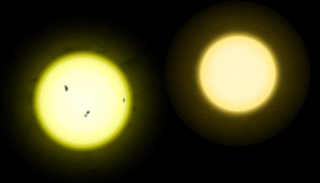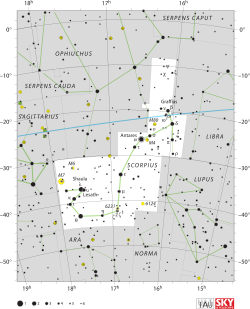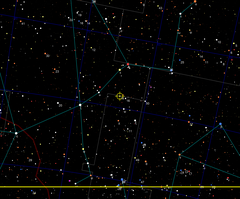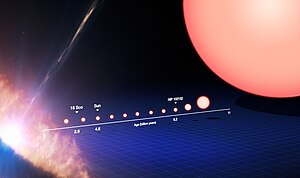
Scutum is a small constellation. Its name is Latin for shield, and it was originally named Scutum Sobiescianum by Johannes Hevelius in 1684. Located just south of the celestial equator, its four brightest stars form a narrow diamond shape. It is one of the 88 IAU designated constellations defined in 1922.
107 Piscium is a single star in the constellation of Pisces. 107 Piscium is the star's Flamsteed designation. John Flamsteed numbered the stars of Pisces from 1 to 113, publishing his Catalogus Britannicus in 1725. He accidentally numbered 107 Piscium twice, as he also allocated it the designation of 2 Arietis. This star is faintly visible to the naked eye with an apparent visual magnitude that has been measured varying between 5.14 and 5.26. However, that finding of variation was not confirmed by subsequent observations and is most likely spurious data. It is located at a distance of about 24.8 light years away from the Sun. 107 Piscium is drifting closer to the Sun with a radial velocity of −33.6, and is predicted to come as close as 15.4 light-years in around 135,800 years.
HD 147513 is a star in the southern constellation of Scorpius. It was first catalogued by Italian astronomer Piazzi in his star catalogue as "XVI 55". With an apparent magnitude of 5.38, according to the Bortle scale it is visible to the naked eye from suburban skies. Based upon stellar parallax measurements by the Hipparcos spacecraft, HD 147513 lies some 42 light years from the Sun.

Solar-type stars, solar analogs, and solar twins are stars that are particularly similar to the Sun. The stellar classification is a hierarchy with solar twin being most like the Sun followed by solar analog and then solar-type. Observations of these stars are important for understanding better the properties of the Sun in relation to other stars and the habitability of planets.
HR 7703 is a binary star system in the constellation of Sagittarius. The brighter component has an apparent visual magnitude of 5.31, which means it is visible from suburban skies at night. The two stars are separated by an angle of 7.10″, which corresponds to an estimated semimajor axis of 56.30 AU for their orbit.
Chi Scorpii, Latinized from χ Scorpii, is a single star in the zodiac constellation of Scorpius. It has an orange hue and can be faintly seen with the naked eye with an apparent visual magnitude of 5.22. Based upon parallax measurements, this star is around 409 light years from the Sun. The star is drifting closer with a radial velocity of −23.6 km/s.
Pi Serpentis, Latinized from π Serpentis, is a solitary white-hued star in the constellation Serpens, located in its head, Serpens Caput. Based upon an annual parallax shift of 18.22 mas as seen from Earth, it is located around 179 light years from the Sun. It is visible to the naked eye with an apparent visual magnitude of 4.82.
Psi Serpentis is a triple star system within the Serpens Caput part of the equatorial constellation Serpens. Based upon an annual parallax shift of 68.22 mas as seen from Earth, it is located approximately 47.8 light years from the Sun. This system came closest approach to the Sun about 585,000 years ago when it made perihelion passage at an estimated distance of 23.27 ly (7.134 pc). Psi Serpentis is faintly visible to the naked eye with an apparent visual magnitude of 5.84.
ω1 Scorpii, Latinised as Omega1 Scorpii, is a star in the zodiac constellation of Scorpius. With an apparent visual magnitude of 3.95 it can be seen with the naked eye, 0.22 degree north of the ecliptic. Parallax measurements of this star give an estimated distance of around 470 light years from the Sun. It is a member of the Scorpius–Centaurus association.
37 Geminorum is a solitary Sun-like star located at the northwest part of the northern constellation of Gemini, about three degrees to the east of the bright star Epsilon Geminorum. The apparent visual magnitude of 37 Geminorum is 5.74, which is just bright enough to be visible to the naked eye on a dark night. It is located at a distance of 57 light years from the Sun based on parallax. This star is drifting closer with a radial velocity of −15 km/s, and is predicted to come as near as 13.8 light-years in approximately a million years. It is positioned close enough to the ecliptic to be subject to lunar occultations, such as happened on April 8, 1984.
3 Cancri is a single star in the zodiac constellation of Cancer, located around 810 light years from the Sun. It is visible to the naked eye as a dim, orange-hued star with an apparent visual magnitude of 5.60. This object is moving further from the Earth with a heliocentric radial velocity of +39.5 km/s, and may be a member of the Hyades group. It is located near the ecliptic and thus is subject to lunar eclipses.
HD 98618 is a yellow-hued star in the northern circumpolar constellation of Ursa Major. It is invisible to the naked eye, having an apparent visual magnitude of just 7.65. Based on measurements, this star is located at a distance of 135 light years from the Sun based on parallax, and is drifting further away with a radial velocity of +7.1 km/s. It is a likely member of the thin disk population and is orbiting the Milky Way at about the same distance from the Galactic Center as the Sun.

58 Eridani is a main-sequence star in the constellation Eridanus. It is a solar analogue, having similar physical properties to the Sun. The star has a relatively high proper motion across the sky, and it is located 43 light years distant. It is a probable member of the IC 2391 moving group of stars that share a common motion through space.
HR 4458 is a binary star system in the equatorial constellation of Hydra. It has the Gould designation 289 G. Hydrae; HR 4458 is the Bright Star Catalogue designation. At a distance of 31.13 light years, it is the closest star system to the Solar System within this constellation. This object is visible to the naked eye as a dim, orange-hued star with an apparent visual magnitude of 5.97. It is moving closer to the Earth with a heliocentric radial velocity of −22 km/s.
HD 222582 is a multiple star system in the equatorial constellation of Aquarius. It is invisible to the naked eye with an apparent visual magnitude of 7.7, but can be viewed with binoculars or a small telescope. The system is located at a distance of 138 light years from the Sun based on parallax, and it is drifting further away with a radial velocity of +12 km/s. It is located close enough to the ecliptic that it is subject to lunar occultations.

HIP 56948 is a solar twin star of type G5V. It is one of the most Sun-like stars yet known in terms of size, mass, temperature, and chemical makeup. The Sun is about 4.6 billion years old, and HIP 56948 is believed to be about 7.1 billion years old. Both stars are between a third and a halfway through their life on the main sequence.

UY Scuti (BD-12°5055) is a red supergiant star in the constellation Scutum. It is possibly considered one of the largest known stars by radius and is also a pulsating variable star, with a maximum brightness of magnitude 8.29 and a minimum of magnitude 10.56. Its radius has been given various estimates with high uncertainty, including 1,708 ± 192 solar radii (1.188×109 ± 134,000,000 kilometres; 7.94 ± 0.89 astronomical units), thus a volume nearly 5 billion times that of the Sun, as based on the modelling spectrum by the Very Large Telescope (VLT), and 755 solar radii (525,000,000 kilometres; 3.51 astronomical units), thus a volume over 2 billion times that of the Sun, as based on parallax measurements by the GAIA DR2 database. It is approximately 1.8 kiloparsecs (5,900 light-years) from Earth as measured by the GAIA EDR3 database. Nonetheless, based on these estimates, if placed at the center of the Solar System, its photosphere in general would possibly approach the orbit of Jupiter.

9 Ceti is a star in the equatorial constellation of Cetus. It has the variable star designation BE Ceti, while 9 Ceti is the Flamsteed designation. It has an apparent visual magnitude of 6.4, which is below the limit that can be seen with the naked eye by a typical observer. Based upon parallax measurements, this star is 69.6 light years away from the Sun.
HD 168009 is a star in the northern constellation of Lyra. It has an apparent visual magnitude of 6.3, placing it just above to below the normal limit of stars visible to the naked eye under good viewing conditions of 6-6.5. An annual parallax shift of 42.93 mas provides a distance estimate of 76 light years. It is moving closer to the Sun with a heliocentric radial velocity of −65 km/s. In about 328,000 years from now, the star will make its closest approach at a distance of around 17 ly (5.1 pc).








